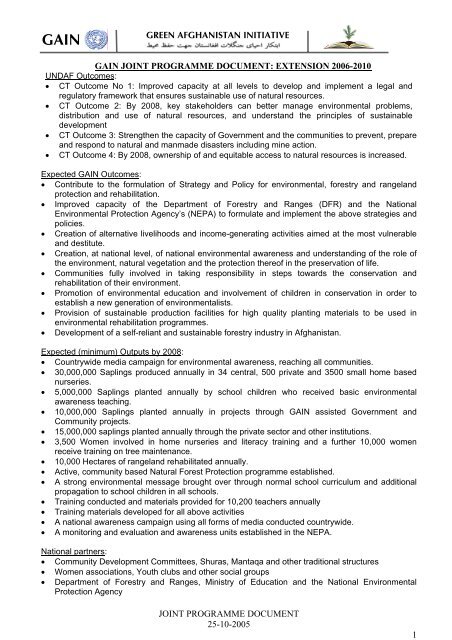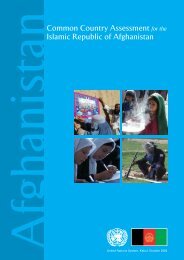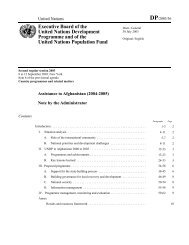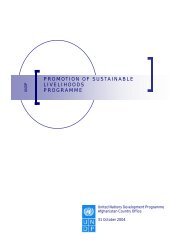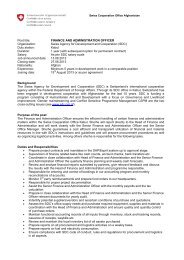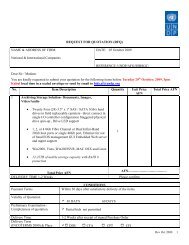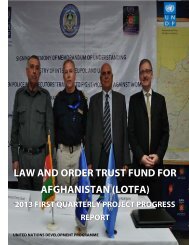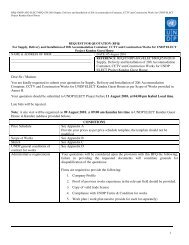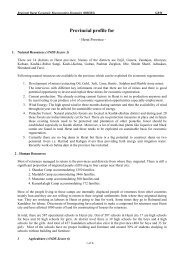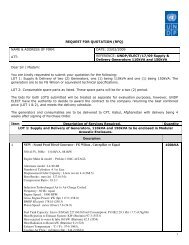Greening Afghanistan Initiative (GAIN) - UNDP Afghanistan
Greening Afghanistan Initiative (GAIN) - UNDP Afghanistan
Greening Afghanistan Initiative (GAIN) - UNDP Afghanistan
You also want an ePaper? Increase the reach of your titles
YUMPU automatically turns print PDFs into web optimized ePapers that Google loves.
<strong>GAIN</strong><br />
GREEN AFGHANISTAN INITIATIVE<br />
<strong>GAIN</strong> JOINT PROGRAMME DOCUMENT: EXTENSION 2006-2010<br />
UNDAF Outcomes:<br />
• CT Outcome No 1: Improved capacity at all levels to develop and implement a legal and<br />
regulatory framework that ensures sustainable use of natural resources.<br />
• CT Outcome 2: By 2008, key stakeholders can better manage environmental problems,<br />
distribution and use of natural resources, and understand the principles of sustainable<br />
development<br />
• CT Outcome 3: Strengthen the capacity of Government and the communities to prevent, prepare<br />
and respond to natural and manmade disasters including mine action.<br />
• CT Outcome 4: By 2008, ownership of and equitable access to natural resources is increased.<br />
Expected <strong>GAIN</strong> Outcomes:<br />
• Contribute to the formulation of Strategy and Policy for environmental, forestry and rangeland<br />
protection and rehabilitation.<br />
• Improved capacity of the Department of Forestry and Ranges (DFR) and the National<br />
Environmental Protection Agency’s (NEPA) to formulate and implement the above strategies and<br />
policies.<br />
• Creation of alternative livelihoods and income-generating activities aimed at the most vulnerable<br />
and destitute.<br />
• Creation, at national level, of national environmental awareness and understanding of the role of<br />
the environment, natural vegetation and the protection thereof in the preservation of life.<br />
• Communities fully involved in taking responsibility in steps towards the conservation and<br />
rehabilitation of their environment.<br />
• Promotion of environmental education and involvement of children in conservation in order to<br />
establish a new generation of environmentalists.<br />
• Provision of sustainable production facilities for high quality planting materials to be used in<br />
environmental rehabilitation programmes.<br />
• Development of a self-reliant and sustainable forestry industry in <strong>Afghanistan</strong>.<br />
Expected (minimum) Outputs by 2008:<br />
• Countrywide media campaign for environmental awareness, reaching all communities.<br />
• 30,000,000 Saplings produced annually in 34 central, 500 private and 3500 small home based<br />
nurseries.<br />
• 5,000,000 Saplings planted annually by school children who received basic environmental<br />
awareness teaching.<br />
• 10,000,000 Saplings planted annually in projects through <strong>GAIN</strong> assisted Government and<br />
Community projects.<br />
• 15,000,000 saplings planted annually through the private sector and other institutions.<br />
• 3,500 Women involved in home nurseries and literacy training and a further 10,000 women<br />
receive training on tree maintenance.<br />
• 10,000 Hectares of rangeland rehabilitated annually.<br />
• Active, community based Natural Forest Protection programme established.<br />
• A strong environmental message brought over through normal school curriculum and additional<br />
propagation to school children in all schools.<br />
• Training conducted and materials provided for 10,200 teachers annually<br />
• Training materials developed for all above activities<br />
• A national awareness campaign using all forms of media conducted countrywide.<br />
• A monitoring and evaluation and awareness units established in the NEPA.<br />
National partners:<br />
• Community Development Committees, Shuras, Mantaqa and other traditional structures<br />
• Women associations, Youth clubs and other social groups<br />
• Department of Forestry and Ranges, Ministry of Education and the National Environmental<br />
Protection Agency<br />
JOINT PROGRAMME DOCUMENT<br />
25-10-2005<br />
1
<strong>GAIN</strong><br />
GREEN AFGANISTAN INITIATIVE<br />
Executive Summary<br />
Years of conflict, uncontrolled logging and overgrazing have resulted in severe environmental<br />
degradation in <strong>Afghanistan</strong>. Appeals from the President and others have resulted in<br />
heightened concern from various stakeholders, including the United Nations Country Team<br />
(UNCT). Rehabilitation and protection of the environment has been declared by Government<br />
as a national priority, and as a strategic outcome of the United Nations Development<br />
Assistance Framework (UNDAF).<br />
In order to complement existing strategy development programmes and bolster Government<br />
efforts, several UN agencies have signed an agreement with the Presidency of <strong>Afghanistan</strong> on<br />
a Joint Programme for intervention, with WFP as the Administrating Agent (AA). Funding is<br />
sourced centrally and managed by the AA, as per Pass-Through fund management<br />
arrangements prescribed in the United Nations Development Group (UNDG) Guidelines for<br />
Joint Programming.<br />
Signatory agencies has made some internal funds available, as seed money to launch pilot<br />
projects in 2005, while a longer term plan is developed. This document gives a description of<br />
the <strong>GAIN</strong> plan of intervention and funding requirements for a five year period from 2006 to<br />
2010.<br />
Specific interventions by different agencies and government are described in the attached<br />
project document and work plan. <strong>GAIN</strong> will focus its activities around schools and community<br />
environmental programmes, while building government capacity, assisting the most vulnerable<br />
in the country and developing a network of nurseries to supply projects with much needed<br />
planting material. Participation of the private sector and creation of alternative livelihoods in<br />
the industry will receive high priority.<br />
It is envisioned that individual agency projects will operate until the end of 2008, when it will be<br />
handed over to related government counterparts and continue with limited participation from<br />
the UN. To secure continuity the budget provide for a further two year of operations under<br />
government management.<br />
Programme Title:<br />
Green <strong>Afghanistan</strong> <strong>Initiative</strong> (<strong>GAIN</strong>)<br />
Programme Duration<br />
(Start/end dates):<br />
1 March 2005 – 31 December 2010<br />
Fund Management Option(s):<br />
Pass-Through<br />
Budget 2005 – 2010<br />
Estimated total budget: $83,862,647<br />
Allocated resources: $4,437,493<br />
(Including cash and in kind)<br />
Unfunded total budget $79,425,154<br />
JOINT PROGRAMME DOCUMENT 25-10-2005<br />
2
<strong>GAIN</strong><br />
GREEN AFGANISTAN INITIATIVE<br />
1. RATIONALE<br />
The United Nations Environment Programme (UNEP) recently conducted a comprehensive Post-conflict<br />
Environmental Assessment in <strong>Afghanistan</strong> which revealed that war, uncontrolled grazing, lack of alternative<br />
cooking fuel, illegal logging, and prolonged interruption of conservation programmes had resulted in severe<br />
degradation of the environment. The report warned of "a future without water, forests, wildlife and clean air if<br />
environmental problems were not immediately addressed."<br />
Satellite imagery reveals that forests and other natural vegetation have significantly decreased since 1978.<br />
Trend analysis shows a highly correlated and steady decline in rainfall. Lack of adequate vegetation has<br />
exacerbated the effects of six consecutive years of drought, resulting in further degradation and causing chronic<br />
shortages of food and drinking water. This, in turn, has necessitated recurrent and costly relief assistance which<br />
is not sustainable.<br />
The magnitude and severity of the environmental<br />
degradation has reached alarming proportions, far<br />
exceeding the capacity of individual ministries and<br />
agencies to resolve single-handedly.<br />
2. INSTITUTIONAL ARRANGEMENTS<br />
In response, President Karzai established a National<br />
Forestry Commission (NFC) in August 2003 to inter-alia,<br />
develop a National Forestry Programme, strengthen the<br />
Department of Forestry and Ranges 1 (DFR), and to<br />
coordinate the efforts of other stakeholders. The Ministry<br />
of Agriculture and Animal Husbandry (MAAHF) was<br />
tasked to develop a strategy for Forestry, Rangeland<br />
and Wildlife with assistance from the Asian Development<br />
Bank. FAO launched a Technical Cooperation Project<br />
(TCP) to support the implementation of this strategy.<br />
Government included agriculture and environment as<br />
national development priorities, and United Nations<br />
Country Team has included rehabilitation and protection<br />
of the environment as a strategic outcome under the<br />
UNDAF.<br />
Nevertheless, inadequate coordination, funding, and a<br />
lack of infrastructure and expertise present formidable<br />
constraints to environmental recovery. These concerns<br />
led to the formation of a Joint Programme of action<br />
known as the Green <strong>Afghanistan</strong> <strong>Initiative</strong> (<strong>GAIN</strong>).<br />
Seven UN agencies and the Presidency of <strong>Afghanistan</strong> are signatories to the <strong>GAIN</strong> programme. Guidance and<br />
collaboration of communities, social development groups, Ministries of Agriculture Animal Husbandry and Food<br />
(MAAHF), Education (MOE), National Environmental Protection Agency (NEPA) and more, will be sought in<br />
order to facilitate the preparation of projects and to effectively pool stakeholder expertise and resources to<br />
augment Government capacity and thereby bolster and advance national environmental management policy<br />
and strategies.<br />
The <strong>GAIN</strong> Joint Programme will be directed by a steering committee, comprised of representatives of signatory<br />
agencies, Presidency and related ministries. WFP will act as the Administrative Agent (AA) and all Funds will be<br />
managed in accordance with the Pass-Through fund managing system as per UNDG guidelines for Joint<br />
Programming 2 . A programme coordination unit (PCU), within WFP, will act as Secretariat to the Steering<br />
Committee and will be responsible for, inter-alia coordination, fund disbursement, accounting, and report<br />
compilation.<br />
1 The Department of Forestry and Ranges (DFR) is part of the Ministry of Agriculture and Animal Husbandry (MAAH)<br />
2 Guidance Note on Joint Programming, United Nation Development Group, December 19, 2003<br />
JOINT PROGRAMME DOCUMENT 25-10-2005<br />
3
<strong>GAIN</strong><br />
GREEN AFGANISTAN INITIATIVE<br />
3. OBJECTIVES<br />
To mobilize funds and technical expertise for preparing, implementing, monitoring and reporting on multisectorial<br />
activities, aiming at “<strong>Greening</strong> <strong>Afghanistan</strong>.” Specifically:<br />
Increasing natural vegetation and forest cover: through community and government supported labour-intensive<br />
projects, involving propagation and sowing of grass, shrub and tree seedlings/saplings, planting and<br />
tree/rangeland maintenance, land clearing, levelling and terracing, watershed plantations, small scale irrigation<br />
works, and creation of windbreaks and live fences.<br />
Providing alternative sustainable livelihoods: through the creation of home and community based nurseries.<br />
Widows, ex-combatants and other vulnerable groups will be assisted in developing private nurseries as an<br />
alternative source of income for the rural poor, who will be supported through food-for-work (FFW) and cash<br />
based programmes. Technical assistance and material support will be provided to encourage private sector and<br />
community nursery and plantation development. Improved environmental quality and restored natural resource<br />
bases will contribute to the security of rural livelihoods in the project areas.<br />
Increasing environmental awareness through education: through integrating environmental issues into the<br />
curriculum for primary students; tree-adoption programme for school children; training of environmental officers<br />
who in turn will conduct related education programmes and outreach activities with communities; and the<br />
launching of a nationwide media campaign involving radio and television.<br />
Building Capacity at Institutional and Community Levels: through training; cooperation on strategic planning and<br />
policy development; close coordination in project design, implementation and monitoring; provision of<br />
equipment, and financial and logistical support in the development of national forests and nurseries.<br />
4. APPROACH<br />
In order to stabilise the environment and increase its ability to mitigate the impact of recurrent drought and<br />
floods and reduce rates of desertification, <strong>GAIN</strong> will adopt an integrated and multi-sectorial approach focusing<br />
on:<br />
Community participation<br />
There is ample evidence that<br />
reforestation and rangeland<br />
management is more successful<br />
where communities are involved in<br />
needs assessment and in project<br />
design, implementation and<br />
management. By permitting<br />
communities and individuals to<br />
participate, to have a voice and<br />
personal stake in “<strong>Greening</strong><br />
projects” and to directly benefit from<br />
them, there is motivation to increase<br />
and sustain outputs.<br />
Worldwide, tree survival rates tend<br />
to be higher in school tree-adoption<br />
programmes, where productive fruit<br />
and nut trees are brought home and<br />
nurtured by the family, than in largescale<br />
plantations. Partial reliance on<br />
this mode will add to forest cover<br />
and contribute to household food<br />
security while defraying costs<br />
associated with long term tree<br />
planting, watering, weeding and<br />
long term maintenance.<br />
JOINT PROGRAMME DOCUMENT 25-10-2005<br />
4
<strong>GAIN</strong><br />
GREEN AFGANISTAN INITIATIVE<br />
Stakeholders<br />
In each Watershed 3 , the following stakeholders will be encouraged to form a working group, facilitated by <strong>GAIN</strong><br />
partners, in order to develop a practical implementation plan for reforestation, rangeland rehabilitation,<br />
environmental conservation, and sustainable natural resource use and management. The roles of these<br />
stakeholders are as follows:<br />
Communities: <strong>GAIN</strong> will strive to implement as many programmes as possible directly with local and rural<br />
communities. Focus will be placed on working with the CDC’s, shuras and mantaqa 4 by strengthening their<br />
environmental awareness and influence to plan, implement and protect interventions in their areas of<br />
governance. In addition to working with community leaders, <strong>GAIN</strong> will also work with schoolchildren and<br />
especially vulnerable groups.<br />
Government: to obtain success, collaboration with government on all levels is essential. The Presidency<br />
signatory to the <strong>GAIN</strong> MOU emphasises this support and collaboration in the greening of the country. Closer<br />
ties and strong capacity building programmes will be established with the Department of Forestry and Ranges<br />
(DFR), National Environmental Protection Agency (NEPA) and Ministry of Education (MOE). These<br />
relationships will be secured through individual Letters of Agreement.<br />
Interaction will include embedding government staff in projects. Training will be given and incentives paid to<br />
these staff that will ultimately be responsible for the continuation of the projects. Aiming to strengthen<br />
government capacities, training will emphasize the role of government staff as extension agents that facilitate<br />
environmental restoration, reforestation and sustainable development in rural <strong>Afghanistan</strong>. Government assets<br />
will also be developed. It is foreseen that full control of all projects will be handed over to government in 2008,<br />
while <strong>GAIN</strong> will be developed as an independent trust fund and a number of the local level initiatives will be<br />
transferred from the state to the private sector in order to stimulate more efficient and effective management.<br />
Private sector: consistent with the Government policy to encourage privatisation, <strong>GAIN</strong> will aim to empower<br />
both individuals and rural communities to develop private nurseries and micro-enterprises for the production of<br />
saplings, watering vessels, low-technology irrigation systems, hoes and other hand tools and equipment that<br />
will be required. Contacts with secondary transformation plants being run by the private sector and / or other<br />
the NGO sector will be actively encouraged.<br />
Non-Governmental Organisations: NGOs offer many comparative advantages, including practical experience<br />
drawn from on-going projects, technical expertise, regular contact with communities, and access to additional<br />
sources of funding. <strong>GAIN</strong> would encourage the participation of those NGOs that can 'add value,' contribute<br />
expertise and matching funds, and share risks as a demonstration of their commitment to project success.<br />
Reforestation and species selection<br />
Internationally, the introduction of foreign flora, for forestry, agricultural or aesthetic reasons, has often changed<br />
local habitats, reduced diversity, and introduced destructive organisms. For this reason, <strong>GAIN</strong> partners have<br />
agreed to avoid importation of foreign species into <strong>Afghanistan</strong>. Only the growing of indigenous and naturalised<br />
species will be supported through <strong>GAIN</strong> projects. Details on the trees, grasses and other species that will be<br />
used in these projects can be obtained from the DFR.<br />
Combining Cash and Food Based Interventions<br />
In many remote areas, food-for-work (FFW) is preferred over cash-for-work (CFW) during the winter months<br />
owing to the inaccessibility of markets. In other food insecure areas, women prefer payment in kind or food<br />
rations as they exercise more direct control over food and can guarantee household food security. Food aid is<br />
also self-targeting, ensuring that the project benefits the most vulnerable and needy. In other areas, cash or a<br />
combination of cash and food is the preferred form of wage for participation in projects. NRVA data and local<br />
assessments will be relied upon to determine the most appropriate mode of payment, which in all cases will be<br />
subject to availability and community endorsement.<br />
Promoting Private Entrepreneurship<br />
Long-term sustainability, the potential for privatisation and for sustainable livelihoods will be the main selection<br />
criteria for projects. In line with government policy, <strong>GAIN</strong> will support the private sector development of<br />
<strong>Afghanistan</strong>'s forests and rangelands where feasible.<br />
3<br />
<strong>Afghanistan</strong> has 7 major river systems consisting of 31 Branch River Watersheds, with close relation to provincial borders, forming ideal<br />
geographical subdivisions for the implementation of a conservation plan. See www.aims.org.af<br />
4<br />
The Mantaqa is a representation of a number of communities clustered together. This form of traditional governance often represents all<br />
communities in a valley or watershed forming an ideal division for environmental protection.<br />
JOINT PROGRAMME DOCUMENT 25-10-2005<br />
5
<strong>GAIN</strong><br />
GREEN AFGANISTAN INITIATIVE<br />
Activities already undertaken and planned include development of private nurseries though the provision of<br />
materials, food and training and the development of community plantations. <strong>GAIN</strong> will limit procurement to<br />
locally produced tools, materials and seeds from the private sector. Currently, <strong>GAIN</strong> is assisting local producers<br />
to develop greenhouses and hydraulic ram pumps for use in assisted projects and for meeting community<br />
demand, and will facilitate expansion of such micro-enterprises.<br />
5. IMPLEMENTATION STRATEGY AND ACTIVITIES<br />
The attached work plan illustrates planned activities. Communities, UN agencies and partners will implement<br />
programmes according to this plan. Three main government counterparts have been identified for collaboration<br />
separating activities accordingly. Activities will be implemented, where possible, through cooperation and<br />
secondment of staff from the government counterparts.<br />
All below mentioned activities are focused on the communities. Through these activities the awareness of the<br />
communities will be raised; responsibility and protection plan for surrounding environment developed; active<br />
rehabilitation programmes of rangelands and forests undertaken:<br />
Communal environmental<br />
management plan:<br />
Watershed Management<br />
Water Management<br />
Provincial<br />
Reforestation<br />
Centre:<br />
Resource<br />
Training<br />
Nursery<br />
Demonstration<br />
Research<br />
Training<br />
Materials<br />
Saplings<br />
EXTENSION<br />
Adopt a Tree<br />
Food for Work<br />
Awareness<br />
COMMUNITY:<br />
Children<br />
(Schools)<br />
Women/Widows<br />
Ex-Combatants<br />
Returnees/IDPs<br />
Men/Labour<br />
Shuras,<br />
Mulas,CDCs<br />
Reforestation:<br />
Communal/ Private<br />
Plantation projects<br />
Private Nurseries<br />
Waste management<br />
Rangeland Management/<br />
Rehabilitation<br />
Department of Forestry and Ranges<br />
Provincial Reforestation Centres will be established in each province, acting as a base of operations for all<br />
interventions. Build around a nursery on government land, each of these centres will supply an average of<br />
500,000 quality saplings to the region; act as training centre for extension workers, nursery owners and more;<br />
be a base of operations for community work through extension, public planting projects, adopt a tree<br />
programme and more.<br />
The most important facet of these centres will be the extension work conducted to communities in the province.<br />
Through regular consultation with community leaders, training of the farmers, women and school children it is<br />
envisioned that the communities will develop their own conservation plans for the development of home<br />
nurseries and the management of communal forests, rangelands, waste and water. Small-scale irrigation<br />
initiatives will be essential to the functioning of these centres.<br />
Nurseries and tree production: the immediate production of large numbers of saplings for use in future projects<br />
is one of the major priorities for the first two years of implementation. This will be achieved through the<br />
establishment of a network of private nurseries countrywide and the provincial centres. The most vulnerable in<br />
rural communities will be encouraged to establish home nurseries.<br />
The current Foster-Mum project, whereby widows and wives of disabled are engaged in nurturing young trees<br />
at home, will be vastly expanded. Each of the 3,500 women participants will be provided material to produce<br />
5,000 saplings in rooftop or backyard greenhouses.<br />
More than 500 medium size private nurseries, producing an average of 25,000 saplings annually are being<br />
established with ex-combatants, returnees and other target groups.<br />
JOINT PROGRAMME DOCUMENT 25-10-2005<br />
6
<strong>GAIN</strong><br />
GREEN AFGANISTAN INITIATIVE<br />
Seed collection and storage: One of the major constraints to reforestation and rangeland recovery in<br />
<strong>Afghanistan</strong> is the shortage of indigenous seed and planting material. Such labour intensive, seed collection,<br />
activities will be implemented inside the watershed programmes and will be combined composting and natural<br />
fertilizer production. Seed storage centres will be constructed in order to improve quality and availability of<br />
necessary seeds of endemic and naturalized tree, shrub and rangeland species.<br />
Plantations and Orchards: <strong>GAIN</strong> will aim to support as many planting projects and ‘greenbelt’ programmes as<br />
possible under the coordination of DFR, municipalities and with individual communities. These highly labour<br />
intensive projects involving the preparation of land, actual planting, maintenance and watering can be<br />
implemented by using FFW, cash wages or combinations thereof. Other inputs e.g. water tankers, pumps, and<br />
tools are to be sourced through <strong>GAIN</strong> and its partners.<br />
Forest Protection Unit: The protection and management of the natural forests of the Eastern region requires<br />
high priority. The objective would be to change existing uncontrolled logging into a well managed, sustainable<br />
industry, bringing the value of the product back to the community. This will be done through intensive studies,<br />
followed by an utilisation plan implemented through a large number of well trained forestry officers.<br />
Ministry of Education<br />
The success of this programme in<br />
rehabilitating forests and rangelands in<br />
<strong>Afghanistan</strong> will ultimately depend on<br />
increased knowledge and awareness by<br />
the public. The importance of schools as<br />
a centre for rural communities, where<br />
young and old meet to acquire<br />
knowledge and address community<br />
issues, are emphasized in this<br />
programme. Formal and informal<br />
education activities will include:<br />
Integration of Environmental Issues into<br />
the National Curriculum: UNICEF, a key<br />
<strong>GAIN</strong> partner, is working with the<br />
Ministry of Education (MOE) on the<br />
development of a primary school<br />
curriculum integrated with the basic<br />
principals of environmental protection<br />
and awareness. Integrating<br />
environmental education and land use<br />
into the curriculum in schools will give teaching and learning a practical focus.<br />
Adopt-a-Tree programme: In cooperation with the MOE and WFP Food-for-education programme, every school<br />
child will receive at least two trees to plant and nurture. The objective will be to add practical experience to<br />
theoretical studies, whilst simultaneously ensuring that schools and surrounding areas are reforested and<br />
stabilized.<br />
National Environmental Protection Agency (NEPA)<br />
It is anticipated that the approval of new legislation will provide NEPA with the mandate to carry out<br />
environmental education and related training activities across <strong>Afghanistan</strong>. <strong>GAIN</strong> will work closely with NEPA in<br />
order to develop and implement this program, including work with national ministries, municipalities, parliament,<br />
religious and community leaders, and community members.<br />
Awareness: A national awareness unit are being established In the NEPA. This unit will be responsible for a<br />
campaign, using all forms of media and more, to support <strong>GAIN</strong> activities and other similar programmes.<br />
Monitoring and evaluation: Similarly a monitoring and evaluation unit are being established. NEPA staffs are<br />
trained to fill this important role of monitoring the natural environment country wide and propose interventions.<br />
The unit will also be responsible to monitor and evaluate active programmes and present recommendations to<br />
the <strong>GAIN</strong> working group.<br />
JOINT PROGRAMME DOCUMENT 25-10-2005<br />
7
<strong>GAIN</strong><br />
GREEN AFGANISTAN INITIATIVE<br />
6. IMPLEMENTATION MECHANISM<br />
<strong>GAIN</strong> will aim to assist and direct implementing agencies in the formulation of proposals and will solicit funding<br />
from all potential sources. As Administrating Agency, WFP will assume this responsibility with technical input<br />
from other participating agencies.<br />
Project Approval Process<br />
All requests will be subject to a thorough review and appraisal process by a Project Approval Committee (PAC)<br />
comprised of representation of all signatory agencies, DFR, MOE and NEPA: The appraisal process will ensure<br />
that:<br />
• the assistance is in accordance with the policies and priorities of Government;<br />
• the request does not duplicate other activities, especially supported by external assistance;<br />
• the request meets <strong>GAIN</strong> criteria governing the selection of watersheds, plant species, beneficiary groups,<br />
cost-effectiveness and sustainability;<br />
• the proposed assistance is technically and operationally feasible and has a potential for follow-up and<br />
medium and long-term catalytic effects;<br />
• the organization has adequate capacity to backstop project implementation (technical and financial<br />
capacity).<br />
• projects have a clear and measurable monitoring and evaluation procedure<br />
• projects may be submitted as per the internal project design formats of each participating agency with a<br />
budget format as provided by the administrative agent.<br />
Authority for project approval rests with the PAC, who may refer the request to appropriate government<br />
department for guidance, to the project steering committee or submit the request for an environmental impact<br />
assessment by the government. <strong>GAIN</strong> will guide the preparation of a project proposal for intervention. Requests<br />
can be submitted by a signatory agency.<br />
With the understanding that different regions of <strong>Afghanistan</strong> can have significantly different costs for the<br />
implementation of these projects, bulk procurement may be chosen for several projects where competitive<br />
bidding will be employed.<br />
Reporting<br />
Each participating agency will prepare quarterly and<br />
annual reports in according with its financial<br />
regulations and rules. Additional requirements and<br />
reporting formats might be requested from the AA in<br />
order to fulfil donor obligations. Projects of a duration<br />
not exceeding nine months will be subject to a mid<br />
term and final report. Reports will be shared with the<br />
<strong>GAIN</strong> PCU in accordance with the Memorandum of<br />
Understanding (MOU). The AA shall prepare<br />
consolidated progress and financial reports for all<br />
projects, and shall provide these quarterly and<br />
annually to the steering committee and all<br />
stakeholders in accordance with the timetable<br />
established in the MOU.<br />
Monitoring and Evaluation<br />
Monitoring occurs throughout the year and culminates<br />
at the annual review of the common work plan. Each<br />
individual agency will do monitoring and evaluation<br />
according to its operational policy. The <strong>GAIN</strong> PCU will invite participating agencies to take part in regular joint<br />
monitoring visits.<br />
Communication<br />
Each participating UN organization shall take appropriate measures to publicize the joint programme and to<br />
give due credit to all other participating UN organizations and government bodies.<br />
Funding Arrangements<br />
Based on agreement of the joint programme coordination mechanism identified at country level, the AA will<br />
negotiate and sign a Letter of Agreement with the donor(s) in respect of the joint programme. The AA will sign a<br />
JOINT PROGRAMME DOCUMENT 25-10-2005<br />
8
<strong>GAIN</strong><br />
GREEN AFGANISTAN INITIATIVE<br />
Memorandum of Understanding with the participating UN organization. Each UN organization participating in<br />
the joint programme will programme and manage activities and funds in line with its established regulations and<br />
rules.<br />
Budget Preparation<br />
Each UN organization will prepare a separate budget, consistent with its procedures, and covering the mutually<br />
agreed parts of the programme that it will be managing. Budget formats will be provided by the <strong>GAIN</strong> PCU. The<br />
<strong>GAIN</strong> PCU will prepare a consolidated budget for approval by the steering committee.<br />
Accounting:<br />
Funds received pursuant to the funding agreement signed with the donor(s) will be recorded by the AA in a joint<br />
programme account. The AA does not record funds channelled to other participating UN organizations as<br />
income. The AA records as income only those funds for which it is programmatically and financially accountable<br />
(i.e. for its part of the joint programme as a participating organization).Each UN organization participating in the<br />
joint programme will account for the funds distributed by the AA in respect of its components in the joint<br />
programme in accordance with its financial regulations and rules.<br />
Admin Fee and Indirect Costs<br />
The AA shall be entitled to allocate one percent (1%) of the amount contributed by donor(s), for its costs of<br />
performing the AA’s functions. This will be subject however to a floor of $20,000 and a ceiling of $100,000.<br />
Each UN organization participating in the joint programme will recover indirect costs in accordance with its<br />
financial regulations and rules and as documented in the Memorandum of Understanding signed with the AA.<br />
The rate of recovery may vary between UN organizations participating in the joint programme, based on their<br />
applicable regulations and rules.<br />
Interest<br />
Interest, if any, will be administered in accordance with the financial regulations and rules of each UN<br />
organization participating in the joint programme.<br />
Balance of Funds<br />
Any funds remaining after the financial closure of the programme will be returned to the AA. Any<br />
unprogrammed funds remaining in the joint programme account after the financial closure of the Joint<br />
Programme will be returned to the donor(s) or utilised in a manner agreed upon between the AA and the<br />
donor(s), and approval of the steering committee.<br />
Audit<br />
Consistent with current practice, each UN organization will be responsible for auditing its own contribution to the<br />
programme as part of its existing regulations and rules. Audit opinions of the individual UN organizations should<br />
be accepted by the other UN organizations.<br />
7. PROJECT BUDGET AND WORK PLAN<br />
Detailed Work Plan with budget totals for individual activities is in Attachment I. Detailed budget available on<br />
request.<br />
8. CONTACTS<br />
Charles Vincent, WFP Country Director, (<strong>Afghanistan</strong>)<br />
charles.vincent@wfp.org<br />
Asif Zaidi, Programme Manager, UNEP (<strong>Afghanistan</strong>)<br />
asif.zaidi@unep.ch<br />
Frederick Lyons, <strong>UNDP</strong> Representative (<strong>Afghanistan</strong>)<br />
frederick.lyons@undp.org<br />
Serge Verniau, FAO Representative, <strong>Afghanistan</strong><br />
serge.verniau@af.fao.org<br />
Gary Helseth, Country Coordinator, UNOPS<br />
(<strong>Afghanistan</strong>)<br />
garyh@unopsmail.org<br />
Tadj Zekrya, <strong>GAIN</strong> Coordinator (<strong>Afghanistan</strong>)<br />
070 657 008 or tadj.zekrya@wfp.org<br />
JOINT PROGRAMME DOCUMENT 25-10-2005<br />
9
Expected Outcome<br />
1. Provincial <strong>GAIN</strong> Centres<br />
This project aims to<br />
establish at lest one<br />
Provincial centre in each<br />
province of the country<br />
presenting a platform for<br />
all other <strong>GAIN</strong> activities,<br />
act as resource centre<br />
for communities and<br />
private individuals, have<br />
a extension facet to all<br />
districts in the province<br />
and produce a bases<br />
number of saplings.<br />
These centres will form a<br />
link between<br />
government, population<br />
and the aid community<br />
Agency<br />
FAO, UNOPS,<br />
WFP<br />
Timeframe with budgets and expected outputs/activities<br />
2005 2006 2007 2008 2009 2010 Total<br />
Forestry and Ranges activities with the DFR<br />
• 10 Centres<br />
established<br />
• 4,000,000<br />
Seedlings planted<br />
in the nursery<br />
• 50 Extension<br />
workers and 25<br />
Government<br />
Counterparts<br />
Trained<br />
• 15 Centres<br />
established<br />
• 5 Centres<br />
Maintained<br />
• 12,500,000<br />
Seedlings planted<br />
in the nursery<br />
• 3,200,000 5<br />
Saplings Produced<br />
• 125 Extension<br />
workers and 125<br />
Government<br />
Counterparts<br />
Trained<br />
• Extension work<br />
continued to more<br />
than 500<br />
communities<br />
• 9 Centres<br />
established<br />
• 25 Centres<br />
Maintained<br />
• 17,500,000<br />
Seedlings planted<br />
in the nursery<br />
• 10,000,000 5<br />
Saplings Produced<br />
• 50 Extension<br />
workers and 50<br />
Government<br />
Counterparts<br />
Trained<br />
• Extension work<br />
continued and<br />
more than 2000<br />
new communities<br />
involved<br />
• 34 Centres<br />
Maintained<br />
• 17,500,000<br />
Seedlings planted<br />
in the nursery<br />
• 14,000,000 5<br />
Saplings Produced<br />
• Extension work<br />
continued and<br />
more than 1000<br />
new communities<br />
involved<br />
• 34 Centres<br />
Maintained<br />
• 17,500,000<br />
Seedlings planted<br />
in the nursery<br />
• 14,000,000 5<br />
Saplings Produced<br />
• Extension work<br />
continued and<br />
more than 2500<br />
new communities<br />
involved<br />
• 34 Centres<br />
Maintained<br />
• 17,500,000<br />
Seedlings planted<br />
in the nursery<br />
• 14,000,000 5<br />
Saplings Produced<br />
• Extension work<br />
continued and<br />
more than 1000<br />
new communities<br />
involved<br />
• 34 Provincial<br />
Centres Established<br />
with a annual output of<br />
14,000,000 saplings<br />
• 55,200,000 5<br />
Saplings Produced<br />
• Extension work for<br />
community mobilisation<br />
in conservation,<br />
plantation and<br />
rangeland management<br />
in over 7,000<br />
communities conducted<br />
Food Requirement 500 2,000 2,000 2,000 6,500<br />
Cash requirement $2,500,000 $7,933,657 $7,755,329 $5,370,908 $5,370,908 $5,370,908 $34,301,708<br />
Co-Funded $2,500,000 $630,000 $0 $0 $0 $0 $3,130,000<br />
Funds Required $0 $7,303,657 $7,755,329 $5,370,908 $5,370,908 $5,370,908 $31,171,708<br />
2. Private nurseries: Ex-Combatants, Returnees etc<br />
Part of the <strong>GAIN</strong><br />
objectives is to develop a<br />
private forestry industry.<br />
These private medium<br />
size nurseries will be<br />
developed with specific<br />
target groups. An<br />
average annual output of<br />
25,000 saplings per<br />
nursery is expected.<br />
FAO, UNOPS,<br />
WFP, <strong>UNDP</strong><br />
(DDR), UNICEF<br />
• 25 Private<br />
Nurseries<br />
established<br />
• 125,000 Tree<br />
seedlings planted<br />
• 250 Private<br />
nurseries<br />
established<br />
• 6,250,000 Tree<br />
Seedlings planted<br />
in the nurseries<br />
• 250 Private<br />
nurseries<br />
established.<br />
• 12,500,000<br />
Tree Seedlings<br />
planted in the<br />
nurseries.<br />
• 5,000,000 5<br />
saplings with<br />
market value of at<br />
least 1,250,000 $<br />
produced in<br />
existing nurseries.<br />
• Nurseries<br />
continue with an<br />
annual output of<br />
10,000,000 5 tree<br />
saplings<br />
• Nurseries<br />
continue with an<br />
annual output of<br />
12,500,000 5 tree<br />
saplings<br />
• Nurseries<br />
continue with an<br />
annual output of<br />
12,500,000 5 tree<br />
saplings<br />
• Sustainable<br />
livelihood created for<br />
500 or more families;<br />
• 43,750,000 5 Tree<br />
saplings produced<br />
selling on the local<br />
market<br />
Food Requirement 32 162 162 356<br />
Cash requirement $56,000 $758,535 $772,859 $0 $0 $0 $1,587,394<br />
Co-Funded $56,000 $215,493 $0 $0 $0 $0 $271,493<br />
Funds Required $0 $543,042 $772,859 $0 $0 $0 $1,315,901<br />
5 This number is based on an 80% survival rate in the nursery<br />
JOINT PROGRAMME DOCUMENT 25-10-2005<br />
10
Expected Outcome<br />
3. Women's nurseries<br />
The objective is to create<br />
a livelihood for poor<br />
women. Women will<br />
receive training in<br />
nursery management<br />
and literacy. A nursery<br />
start-up kit will be<br />
provided. Nurseries will<br />
be operated either on a<br />
collective basis or<br />
individual backyard<br />
nurseries.<br />
Agency<br />
FAO, UNOPS,<br />
WFP<br />
4. Community Interventions<br />
Communities are to take FAO, UNOPS,<br />
full control, through WFP, UNEP<br />
extension education and<br />
training, of their<br />
immediate environment.<br />
This will include water<br />
management, increase<br />
of natural vegetation,<br />
rangeland management<br />
with an emphasis on tree<br />
planting.<br />
Timeframe with budgets and expected outputs/activities<br />
2005 2006 2007 2008 2009 2010 Total<br />
• 400 Women<br />
start to receive<br />
basic training in<br />
nursery<br />
management and<br />
literacy<br />
• 125,000<br />
Seedlings planted<br />
in nurseries<br />
• 1600 + 400<br />
Women to receive<br />
basic training in<br />
nursery<br />
management and<br />
literacy<br />
• 5,000,000<br />
Seedlings planted<br />
in nurseries<br />
• 100,000 5<br />
Saplings produced<br />
• 1500 Women to<br />
receive basic<br />
training in nursery<br />
management and<br />
literacy<br />
• 7,500,000<br />
Seedlings planted<br />
in nurseries.<br />
• 4,000,000 5<br />
Saplings produced<br />
• 7,500,000<br />
Seedlings planted<br />
in nurseries<br />
• 5,000,000 5<br />
Saplings produced<br />
• 7,500,000<br />
Seedlings planted<br />
in nurseries<br />
• 5,000,000 5<br />
Saplings produced<br />
• 7,500,000<br />
Seedlings planted<br />
in nurseries<br />
• 5,000,000 5<br />
Saplings produced<br />
for selling<br />
• 3500 Women<br />
received basic training<br />
in nursery management<br />
and literacy and receive<br />
income from a<br />
sustainable livelihood<br />
• 24,100,000 5<br />
Saplings produced for<br />
selling. This has a<br />
current market value of<br />
over $6,000,000<br />
Food Requirement 400 1,200 972 400 2,972<br />
Cash requirement $406,080 $306,180 $0 $0 $0 $712,261<br />
Co-Funded $0 $0 $0 $0 $0 $0<br />
Funds Required $0 $406,080 $306,180 $0 $0 $0 $712,261<br />
• Identification<br />
and sensitization<br />
of up to 400<br />
communities done<br />
through extension<br />
work of 10<br />
Provincial Centres<br />
• Identification<br />
and sensitization of<br />
up to 2500<br />
communities done<br />
through extension<br />
work of 25<br />
Provincial Centres<br />
• 400<br />
Communities<br />
assisted with<br />
innovative<br />
technology and<br />
systems in order to<br />
assist active tree<br />
planting and<br />
conservation<br />
projects at a cost of<br />
500$ per<br />
community<br />
• Minimum of<br />
400,000 trees<br />
planted and<br />
maintained by<br />
communities<br />
• Identification<br />
and sensitization of<br />
up to 3500<br />
communities done<br />
through extension<br />
work of 15<br />
Provincial Centres;<br />
• 2,500<br />
Communities<br />
assisted with<br />
innovative<br />
technology and<br />
systems in order to<br />
assist active tree<br />
planting and<br />
conservation<br />
projects at a cost of<br />
500$ per<br />
community<br />
• Minimum of<br />
5,000,000 trees<br />
planted and<br />
maintained by<br />
communities<br />
• Identification<br />
and sensitization of<br />
up to 3500<br />
communities done<br />
through extension<br />
work of 15<br />
Provincial Centres<br />
• 3,500<br />
Communities<br />
assisted with<br />
innovative<br />
technology and<br />
systems in order to<br />
assist active tree<br />
planting and<br />
conservation<br />
projects at a cost of<br />
500$ per<br />
community;<br />
• Minimum of<br />
7,000,000 trees<br />
planted and<br />
maintained by<br />
communities<br />
• Identification<br />
and sensitization of<br />
up to 3500<br />
communities done<br />
through extension<br />
work of 15<br />
Provincial Centres<br />
• 3,500<br />
Communities<br />
assisted with<br />
innovative<br />
technology and<br />
systems in order to<br />
assist active tree<br />
planting and<br />
conservation<br />
projects at a cost of<br />
500$ per<br />
community;<br />
• Minimum of<br />
7,000,000 trees<br />
planted by<br />
communities<br />
• Identification<br />
and sensitization of<br />
up to 3500<br />
communities done<br />
through extension<br />
work of 15<br />
Provincial Centres;<br />
• 3,500<br />
Communities<br />
assisted with<br />
innovative<br />
technology and<br />
systems in order to<br />
assist active tree<br />
planting and<br />
conservation<br />
projects at a cost of<br />
500$ per<br />
community;<br />
• Minimum of<br />
7,000,000 trees<br />
planted by<br />
communities<br />
• 17,500 communities<br />
involved and trained<br />
into this programme<br />
through extension work<br />
of 35 Provincial<br />
Centres;<br />
• 14,000 Communities<br />
assisted with innovative<br />
technology and<br />
systems in order to<br />
assist active tree<br />
planting and<br />
conservation projects at<br />
a cost of 500$ per<br />
community;<br />
• Minimum of<br />
26,000,000 6 trees<br />
planted by communities<br />
at an average of 2,000<br />
per community per<br />
year.<br />
Food Requirement 5,000 5,000 5,000 15,000<br />
Cash requirement $540,000 $1,350,000 $1,836,000 $1,350,000 $1,836,000 $6,912,000<br />
Co-Funded $0 $0 $0 $0 $0 $0<br />
Funds Required $0 $540,000 $1,350,000 $1,836,000 $1,350,000 $1,836,000 $6,912,000<br />
6 This figure only reflect those communities newly assigned to the project and not the continuation of community plantings in previous years.<br />
JOINT PROGRAMME DOCUMENT 25-10-2005<br />
11
Expected Outcome<br />
Agency<br />
5. Rangeland Management<br />
Through the extension FAO, UNOPS,<br />
work to communities, WFP, UNEP and<br />
training and other active <strong>UNDP</strong><br />
labour intensive<br />
operations this project<br />
will seek to improve the<br />
quality of rangelands and<br />
lift the carrying capacity.<br />
Timeframe with budgets and expected outputs/activities<br />
2005 2006 2007 2008 2009 2010 Total<br />
• The same 400<br />
communities<br />
targeted through<br />
community<br />
forestry trained<br />
and assisted to<br />
produce a<br />
rangeland<br />
management<br />
plan.<br />
• The same 2500<br />
communities<br />
targeted through<br />
community forestry<br />
trained and<br />
assisted to produce<br />
a rangeland<br />
management plan.<br />
• At least<br />
10,000ha of<br />
rangelands directly<br />
seeded and<br />
planted with<br />
grasses and<br />
shrubs.<br />
• The same 3500<br />
communities<br />
targeted through<br />
community forestry<br />
trained and<br />
assisted to produce<br />
a rangeland<br />
management plan.<br />
• At least<br />
10,000ha of<br />
rangelands directly<br />
seeded and<br />
planted with<br />
grasses and<br />
shrubs.<br />
• The same 3500<br />
communities<br />
targeted through<br />
community forestry<br />
trained and<br />
assisted to produce<br />
a rangeland<br />
management plan.<br />
• At least<br />
10,000ha of<br />
rangelands directly<br />
seeded and<br />
planted with<br />
grasses and<br />
shrubs.<br />
• The same 3500<br />
communities<br />
targeted through<br />
community forestry<br />
trained and<br />
assisted to produce<br />
a rangeland<br />
management plan.<br />
• At least<br />
10,000ha of<br />
rangelands directly<br />
seeded and<br />
planted with<br />
grasses and<br />
shrubs.<br />
• The same 3500<br />
communities<br />
targeted through<br />
community forestry<br />
trained and<br />
assisted to produce<br />
a rangeland<br />
management plan.<br />
• At least<br />
10,000ha of<br />
rangelands directly<br />
seeded and<br />
planted with<br />
grasses and<br />
shrubs.<br />
• Identification and<br />
sensitization of up to<br />
14,000 communities<br />
done through extension<br />
work of 10 Provincial<br />
Centres;<br />
• Direct seeding of at<br />
least 50,000 hectares of<br />
rangelands<br />
Food Requirement 200 200 200 600<br />
Cash requirement $711,404 $623,052 $569,592 $569,592 $569,592 $3,043,232<br />
Co-Funded $35,000 $0 $0 $0 $0 $35,000<br />
Funds Required $0 $676,404 $623,052 $569,592 $569,592 $569,592 $3,008,232<br />
6. Seed collection and seed bank establishment<br />
FAO, UNOPS,<br />
WFP<br />
The project will aim to<br />
establish a countrywide<br />
source of quality,<br />
indigenous germoplasm<br />
for use in related<br />
projects. Seeds to be<br />
kept in suitable quantities<br />
and conditions to meet<br />
the countrywide needs<br />
quantitive and qualitive.<br />
• Seed collection<br />
projects initiated<br />
in two areas<br />
through food for<br />
work activities<br />
• Collection 1mt<br />
of pistachio, cedar<br />
and other seeds<br />
• Basic storage<br />
facilities developed<br />
in 25 provincial<br />
<strong>GAIN</strong> centres and<br />
in Kabul.<br />
• Seed collection,<br />
cleaning and<br />
storage<br />
programmes<br />
conducted at all<br />
<strong>GAIN</strong> centres.<br />
• At least 25mt of<br />
Seeds collected<br />
• Basic storage<br />
facilities developed<br />
lithe additional 10<br />
provincial <strong>GAIN</strong><br />
centres.<br />
• Seed collection,<br />
cleaning and<br />
storage<br />
programmes<br />
conducted at all<br />
<strong>GAIN</strong> centres.<br />
• At least 34mt of<br />
Seeds collected A<br />
germination centre<br />
developed at Kabul<br />
Provincial Centre<br />
• Seed collection,<br />
cleaning and<br />
storage<br />
programmes<br />
conducted at all<br />
<strong>GAIN</strong> centres.<br />
• At least 34mt of<br />
Seeds collected.<br />
• Seed collection,<br />
cleaning and<br />
storage<br />
programmes<br />
conducted at all<br />
<strong>GAIN</strong> centres.<br />
• At least 34mt of<br />
Seeds collected.<br />
• Seed collection,<br />
cleaning and<br />
storage<br />
programmes<br />
conducted at all<br />
<strong>GAIN</strong> centres.<br />
• At least 34mt of<br />
Seeds collected.<br />
• Basic storage<br />
facilities developed in<br />
provincial <strong>GAIN</strong><br />
centres.<br />
• Seed collection,<br />
cleaning and storage<br />
programmes conducted<br />
at all <strong>GAIN</strong> centres.<br />
• At least 162mt of<br />
Seeds collected<br />
Food Requirement 70 72 101 101 344<br />
Cash requirement $264,794 $189,570 $164,570 $164,570 $164,570 $948,076<br />
Co-Funded $0 $0 $0 $0 $0 $0<br />
Funds Required $0 $264,794 $189,570 $164,570 $164,570 $164,570 $948,076<br />
JOINT PROGRAMME DOCUMENT 25-10-2005<br />
12
Expected Outcome Agency<br />
Timeframe with budgets and expected outputs/activities<br />
2005 2006 2007 2008 2009 2010 Total<br />
7. Natural Forests Protection Programme<br />
At the end of this period FAO<br />
• Recruitment of • Survey • Continuation of • Continuation of • Continuation of • Continuation of • Utilisation and<br />
it is foreseen that the<br />
specialists and conducted and building community building community building community building community protection plan<br />
government and specific<br />
the DFR would have<br />
management<br />
team.<br />
implementation<br />
plan prepared by<br />
operations and<br />
developing their<br />
operations and<br />
developing their<br />
operations and<br />
developing their<br />
operations and<br />
developing their<br />
developed for the<br />
usage of the natural<br />
developed a scientifically<br />
• Start and management team. involvement in involvement in involvement in involvement in forests of Eastern<br />
based sustainable<br />
utilisation plan for the<br />
natural forests of eastern<br />
<strong>Afghanistan</strong>; that illegal<br />
logging would be<br />
planning of<br />
surveys and<br />
utilisation plan<br />
• Establishment<br />
of 2 operational<br />
offices, attached to<br />
<strong>GAIN</strong> provincial<br />
centres;<br />
forest protection<br />
and utilisation<br />
forest protection<br />
and utilisation<br />
forest protection<br />
and utilisation<br />
forest protection<br />
and utilisation<br />
<strong>Afghanistan</strong>;<br />
• 2 Protection offices<br />
established. 100<br />
Forestry Officers<br />
trained and maintained<br />
reduced to minimal<br />
• Training of t 100<br />
in the field for the<br />
influence, this utilisation<br />
Forestry Officers;<br />
implementation of the<br />
plan be implemented<br />
Starting operations<br />
protection plan;<br />
through a team of well<br />
of community<br />
• All communities in<br />
trained forestry officers,<br />
sensitization<br />
the region actively<br />
assisted by communities,<br />
involved in forest<br />
with access to resources<br />
protection and<br />
to achieve their mission<br />
sustainable utilisation.<br />
and all necessary<br />
assistance of<br />
Food Requirement 50 500 500 500 1,550<br />
governance and force Cash requirement $1,016,188 $633,528 $514,728 $514,728 $514,728 $3,193,900<br />
provided by the law Co-Funded $70,000 $0 $0 $0 $0 $70,000<br />
enforcement institutions<br />
of the government. Funds Required $0 $946,188 $633,528 $514,728 $514,728 $514,728 $3,123,900<br />
8. Direct Assistance to DFR and other Government Planting Projects<br />
This activity of large FAO, UNOPS,<br />
scale, sustainable and WFP<br />
well maintained<br />
plantations on<br />
government land,<br />
implemented as part of<br />
the Provincial Centres<br />
Project, will set examples<br />
and encourage Afghan<br />
people to take part in the<br />
re-greening and<br />
protection of their<br />
environment.<br />
• Assistance to<br />
implementation of<br />
the Kabul<br />
(200,000) and<br />
Kandahar<br />
(120,000<br />
saplings)<br />
Greenbelt<br />
programmes<br />
• Pump and<br />
irrigation systems<br />
installed for<br />
watering and<br />
fences made for<br />
protection<br />
• Basic<br />
maintenance and<br />
watering of<br />
previously planted<br />
saplings<br />
• Up to 2,000,000<br />
saplings planted<br />
through large scale<br />
cash/food for work<br />
based labour<br />
intensive activities.<br />
• Pump and<br />
irrigation systems<br />
installed for<br />
watering and<br />
fences made for<br />
protection<br />
• Basic<br />
maintenance and<br />
watering of<br />
previously planted<br />
saplings<br />
• Up to 3,000,000<br />
saplings planted<br />
through large scale<br />
cash/food for work<br />
based labour<br />
intensive activities<br />
• Pump and<br />
irrigation systems<br />
installed for<br />
watering and<br />
fences made for<br />
protection<br />
• Basic<br />
maintenance and<br />
watering of<br />
previously planted<br />
saplings<br />
• Up to 3,000,000<br />
saplings planted<br />
through large scale<br />
cash/food for work<br />
based labour<br />
intensive activities<br />
• Pump and<br />
irrigation systems<br />
installed for<br />
watering and<br />
fences made for<br />
protection<br />
• Basic<br />
maintenance and<br />
watering of<br />
previously planted<br />
saplings<br />
• Up to 3,000,000<br />
saplings planted<br />
through large scale<br />
cash/food for work<br />
based labour<br />
intensive activities<br />
• Pump and<br />
irrigation systems<br />
installed for<br />
watering and<br />
fences made for<br />
protection<br />
• Basic<br />
maintenance and<br />
watering of<br />
previously planted<br />
saplings<br />
• Up to 3,000,000<br />
saplings planted<br />
through large scale<br />
cash/food for work<br />
based labour<br />
intensive activities<br />
• Pump and<br />
irrigation systems<br />
installed for<br />
watering and<br />
fences made for<br />
protection<br />
• Basic maintenance<br />
and watering of<br />
saplings conducted<br />
• Up to 14,000,000<br />
saplings planted<br />
through large scale<br />
cash/food for work<br />
based labour intensive<br />
activities;<br />
• Pump and irrigation<br />
systems installed for<br />
watering and fences<br />
made for protection<br />
Food Requirement 500 3,000 3,000 2,000 8,500<br />
Cash requirement $85,000 $2,250,450 $3,060,612 $3,060,612 $3,060,612 $3,060,612 $14,577,898<br />
Co-Funded $85,000 $0 $0 $0 $0 $0 $85,000<br />
Funds Required $0 $2,250,450 $3,060,612 $3,060,612 $3,060,612 $3,060,612 $14,492,898<br />
JOINT PROGRAMME DOCUMENT 25-10-2005<br />
13
Expected Outcome<br />
Agency<br />
1.Curriculum Development (Budget combined with AAT)<br />
To equip the educational UNICEF, UNEP, • Inclusion of a<br />
system with materials,<br />
training and well<br />
developed integrated<br />
and additional<br />
curriculum, to constantly<br />
produce, nationwide a<br />
new generation of active<br />
environmentalists<br />
<strong>UNDP</strong>, WFP strong<br />
environmental<br />
message and<br />
information in the<br />
national<br />
education<br />
curriculum.<br />
Timeframe with budgets and expected outputs/activities<br />
2005 2006 2007 2008 2009 2010 Total<br />
Education Activities with MOE<br />
• Inclusion of a<br />
strong<br />
environmental<br />
message and<br />
information in the<br />
national education<br />
curriculum<br />
• Development of<br />
an additional<br />
environmental<br />
curriculum and<br />
• Training for<br />
7,500 teachers.<br />
• Inclusion of a<br />
strong<br />
environmental<br />
message and<br />
information in the<br />
national education<br />
curriculum;<br />
• Development of<br />
an additional<br />
environmental<br />
curriculum and<br />
• Training for<br />
10,200 teachers.<br />
• Continued<br />
operation and<br />
teacher training<br />
• Continued<br />
operation and<br />
teacher training<br />
• Continued<br />
operation and<br />
teacher training<br />
• Inclusion of a strong<br />
environmental message<br />
and information in the<br />
national education<br />
curriculum;<br />
• Development of an<br />
additional<br />
environmental<br />
curriculum and<br />
• Training for 10,200<br />
teachers annually.<br />
2.Adopt a Tree<br />
In addition to<br />
WFP<br />
environmental teaching<br />
at school level this<br />
project will develop the<br />
practical skills of children<br />
to take part in the<br />
greening effort and<br />
develop their sensitivity<br />
to the environment while<br />
providing a baseline for<br />
trees planted with<br />
enhanced chances of<br />
survival<br />
• Distributions of<br />
120,000 trees to<br />
the same number<br />
of children in the<br />
spring and<br />
500,000<br />
trees/children in<br />
autumn;<br />
• Distributions of<br />
3,750,000 trees to<br />
the same number<br />
of children<br />
• publicity<br />
materials<br />
distributed to<br />
targeted schools<br />
• establishment<br />
of AAT office in 25<br />
provincial <strong>GAIN</strong><br />
centres<br />
• Distributions of<br />
5,000,000 trees to<br />
the same number<br />
of children<br />
• publicity<br />
materials<br />
distributed to<br />
targeted schools<br />
• establishment<br />
of AAT office in 14<br />
provincial <strong>GAIN</strong><br />
centres<br />
• Distributions of<br />
5,000,000 trees to<br />
the same number<br />
of children<br />
• publicity<br />
materials<br />
distributed to<br />
targeted schools<br />
• Distributions of<br />
5,000,000 trees to<br />
the same number<br />
of children<br />
• publicity<br />
materials<br />
distributed to all<br />
schools,<br />
• Distributions of<br />
5,000,000 trees to<br />
the same number<br />
of children<br />
• publicity<br />
materials<br />
distributed to all<br />
schools<br />
• Distributions of<br />
24,350,000 trees to the<br />
same number of<br />
children<br />
• publicity materials<br />
distributed to tall<br />
schools<br />
• provincial AAT<br />
offices established in all<br />
<strong>GAIN</strong> centres<br />
Food Requirement 0<br />
Cash requirement $346,000 $2,600,694 $2,643,797 $2,139,437 $2,139,437 $2,139,437 $12,008,801<br />
Co-Funded $346,000 $0 $0 $0 $0 $0 $346,000<br />
Funds Required $0 $2,600,694 $2,643,797 $2,139,437 $2,139,437 $2,139,437 $11,662,801<br />
JOINT PROGRAMME DOCUMENT 25-10-2005<br />
14
Expected Outcome<br />
Agency<br />
1.National awareness Campaign (Budget combined with M&E unit)<br />
Creation of a nationwide <strong>UNDP</strong>, UNEP • Establishment<br />
awareness and<br />
of regional<br />
increased levels of<br />
operations unit in<br />
knowledge of the<br />
the Northern<br />
environment and effects<br />
Pistachio belt<br />
on everyday life and<br />
• Establishment<br />
means to preserve,<br />
of<br />
resulting in an improved<br />
Awareness/Media<br />
environment through<br />
unit in NEPA<br />
public involvement.<br />
2. Creation of an Monitoring and Evaluation Unit.<br />
Implementation of<br />
National environmental<br />
protection policies and<br />
directing interventions in<br />
this field<br />
<strong>UNDP</strong>, UNEP • Establishment<br />
of M&E unit in<br />
NEPA through<br />
training and<br />
infrastructure<br />
development<br />
TOTAL<br />
Timeframe with budgets and expected outputs/activities<br />
2005 2006 2007 2008 2009 2010 Total<br />
Awareness and Monitoring with NEPA<br />
• Development of<br />
training materials<br />
for private nursery<br />
owners, extension<br />
workers and more<br />
• Training<br />
conducted in<br />
villages specifically<br />
targeting women<br />
and children<br />
• Printing of large<br />
number of publicity<br />
materials<br />
• National radio<br />
and television<br />
programmes and<br />
advertisements<br />
developed<br />
• Establishment<br />
and training of<br />
regional monitoring<br />
units<br />
• Coordination<br />
with other<br />
ministries and<br />
implementing<br />
agencies<br />
• Independent<br />
monitoring and<br />
recommendations<br />
made to <strong>GAIN</strong>,<br />
government and<br />
private sector<br />
• Continued<br />
Operations<br />
• Continued<br />
Operations<br />
• Continued<br />
Operations<br />
• Continued<br />
Operations<br />
• Continued<br />
Operations<br />
• Continued<br />
Operations<br />
• Continued<br />
Operations<br />
• Continued<br />
Operations<br />
• A national<br />
environmental<br />
awareness unit<br />
established inside<br />
NEPA<br />
• Regional centres<br />
developed attached to<br />
<strong>GAIN</strong> Provincial<br />
Centres<br />
• More than 100,000<br />
pamphlets, booklets etc<br />
printed and distributed<br />
• More than 10,000<br />
women received<br />
intensive training on<br />
conservation, tree care<br />
and more<br />
• Thousands of<br />
villages targeted<br />
through campaigns<br />
• Establishment of<br />
M&E unit in NEPA<br />
through training and<br />
infrastructure<br />
• Regional monitoring<br />
units established<br />
• Coordination with<br />
other ministries and<br />
implementing agencies<br />
• Independent<br />
monitoring and<br />
recommendations<br />
made to <strong>GAIN</strong>,<br />
government and private<br />
sector<br />
Food Requirement 180 180 180 540<br />
Cash requirement $500,000 $1,332,374 $1,320,710 $1,141,430 $1,141,430 $1,141,430 $6,577,376<br />
Co-Funded $500,000 $0 $0 $0 $0 $0 $500,000<br />
Funds Required $0 $1,332,374 $1,320,710 $1,141,430 $1,141,430 $1,141,430 $6,077,376<br />
Food<br />
Requirement<br />
1,552 12,314 12,115 10,381 0 0 36,362<br />
Cash requirement $3,487,000 $17,814,177 $18,655,637 $14,797,278 $14,311,278 $14,797,278 $83,862,647<br />
Co-Funded $3,487,000 $950,493 $0 $0 $0 $0 $4,437,493<br />
Funds Required $0 $16,863,684 $18,655,637 $14,797,278 $14,311,278 $14,797,278 $79,425,154<br />
JOINT PROGRAMME DOCUMENT 25-10-2005<br />
15


